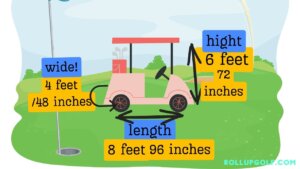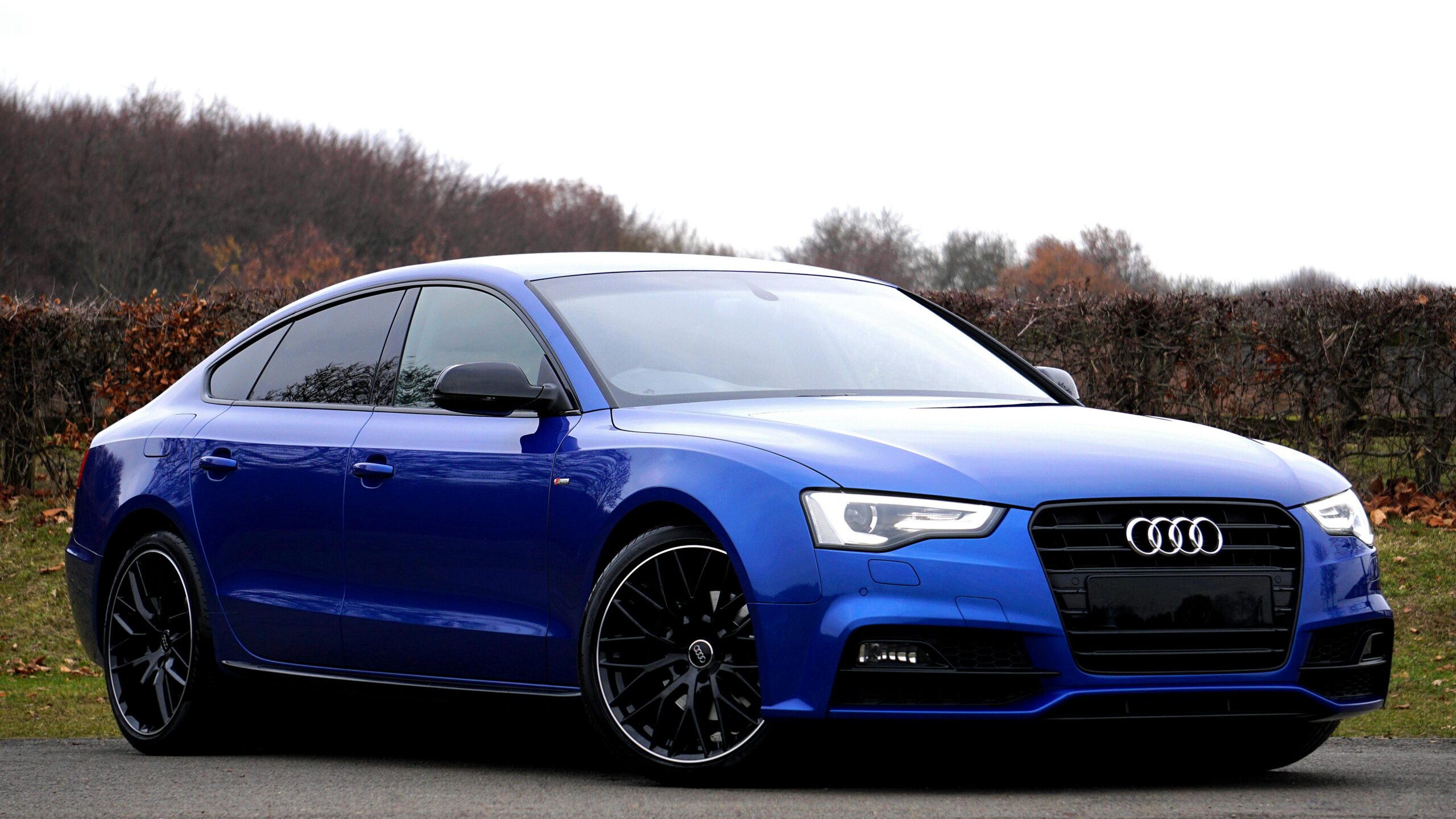
Golf carts have become an integral part of various settings, from golf courses to residential neighborhoods and commercial spaces. One often overlooked aspect of these versatile vehicles is their width, a crucial dimension that significantly influences their functionality. In this article, we’ll explore the diverse dimensions of golf carts, focusing on the question: “How wide is a golf cart?”
Read also: How Many Golf Lessons Should I Take 2024
How wide is a golf cart?
The width of a golf cart can vary depending on the make and model, but most standard golf carts are around 4 feet wide, or 48 inches. This is wide enough to comfortably seat two people side-by-side.

Here are some additional details about golf cart widths:
- Narrowest golf carts: Around 47 inches wide.
- Widest golf carts: Around 58 inches wide.
- Limo golf carts: Can be up to 6 feet wide.
If you’re unsure about the width of a specific golf cart, you can always check the manufacturer’s specifications.
I hope this helps! Let me know if you have any other questions.
How many feet is a 6-seater golf cart?

Six-seater golf carts are typically longer than standard two-seaters to comfortably accommodate the additional passengers. On average, you can expect a 6-seater golf cart to be around 9.5 feet long, or 114 inches. This is just an average, and the actual length can vary depending on the specific make, model, and features.
Here’s a breakdown of typical 6-seater golf cart lengths:
- Shortest: Around 9 feet (108 inches)
- Longest: Around 11.5 feet (138 inches)
Some factors that can influence the length of a 6-seater golf cart include:
- Stretching modifications: Some manufacturers offer stretched versions of their standard models, which can be significantly longer than the original version.
- Cargo bed presence: Some 6-seaters have a small cargo bed in the back, which adds to the overall length.
- Wheelbase: The distance between the front and rear axles can affect the overall length of the cart.
If you’re interested in the exact length of a specific 6-seater golf cart, the best way to find out is to check the manufacturer’s specifications or measure it yourself.
I hope this helps! Let me know if you have any other questions about 6-seater golf carts.
Standard Dimensions of Golf Carts
The width of a standard golf cart typically falls within a specific range. On average, a standard golf cart is around 4 feet wide. However, it’s crucial to note that this can vary based on the make and model of the cart, with different manufacturers producing carts with slightly different dimensions.
Regulations and Restrictions
Understanding the width of a golf cart is not just a matter of preference; it’s often a legal necessity. Many regions have regulations in place regarding the dimensions of golf carts, particularly when they are used beyond the golf course. These regulations are in place to ensure safety on roads and other public spaces.
Utility and Functionality
The width of a golf cart directly impacts its utility and functionality. A narrower cart might be more maneuverable, making it suitable for tight spaces, while a wider cart could provide more stability. Exploring how these factors align with your intended use is crucial when choosing a golf cart.
Customization Options
For those seeking a more personalized experience, customization options abound. Golf cart owners can modify the width of their carts through various aftermarket accessories and modifications. However, it’s essential to consider the implications of such alterations, including potential impacts on performance and compliance with regulations.
Golf Course Considerations
Golf courses often set specific guidelines regarding the dimensions of golf carts. This is not only to maintain the aesthetics of the course but also to ensure that the carts can navigate the terrain without causing damage. Being aware of these guidelines is essential for both golfers and course maintenance personnel.
Read also: How Much Is a Golf Cart?
Comparisons with Other Vehicles
Comparing the width of golf carts to traditional vehicles and other recreational vehicles provides valuable insights. Understanding how golf carts fit into the broader spectrum of vehicle dimensions can help users make informed decisions based on their specific needs.
Environmental Impact
The width of a golf cart can also impact its environmental footprint. Smaller, more compact carts may be more energy-efficient, contributing to sustainability efforts. Exploring the environmental implications of different widths adds an eco-conscious perspective to the decision-making process.
Trends in Golf Cart Design
The world of golf cart design is not stagnant. Recent trends indicate a shift toward more innovative and stylish designs, and this includes variations in width. Exploring these trends provides a glimpse into the future of golf cart design and how it may influence user preferences.
1. Electric Powertrains Dominate
One of the most prominent trends is the widespread adoption of electric powertrains. Electric golf carts have gained popularity due to their eco-friendly nature, reduced noise levels, and lower maintenance requirements. Advancements in battery technology have extended the range of electric carts, making them a compelling choice for environmentally conscious users.
2. Smart Technology Integration
Golf carts are becoming smarter with the integration of cutting-edge technologies. GPS navigation systems, touch-screen displays, and connectivity features are becoming standard offerings. These tech-savvy carts enhance the overall user experience, providing real-time data on golf courses, weather conditions, and even enabling users to control various functions through mobile apps.
3. Lightweight Materials and Innovative Construction
Manufacturers are exploring lightweight materials and innovative construction techniques to enhance the performance and efficiency of golf carts. The use of materials like carbon fiber and aluminum not only reduces the overall weight but also contributes to improved energy efficiency and maneuverability.
4. Customization Options for Personalization
Personalization has become a key driver in golf cart design. Manufacturers are offering a plethora of customization options, allowing users to tailor their carts to match individual preferences. From vibrant color choices to personalized interiors, golf cart enthusiasts can now express their unique style through their vehicles.
Read also: Golf
5. Multi-Purpose Functionality
The traditional image of golf carts confined to golf courses is evolving. Modern designs are incorporating multi-purpose functionality, making these vehicles suitable for various settings. Whether used for transportation in residential communities, on college campuses, or within commercial complexes, golf carts are adapting to diverse needs.
6. Efficiency and Sustainability
Efficiency and sustainability are at the forefront of design considerations. Manufacturers are focusing on creating energy-efficient models with longer battery life. Solar-powered carts are also emerging as a sustainable alternative, harnessing energy from the sun to power electric motors and reduce dependency on traditional charging methods.
7. Enhanced Safety Features
Safety is a paramount concern in golf cart design. Recent trends include the incorporation of advanced safety features such as collision avoidance systems, automatic braking, and improved lighting for enhanced visibility. These features not only prioritize user safety but also align with regulatory requirements.
8. Compact and Foldable Designs
Space-saving solutions are gaining traction, particularly in urban environments. Compact and foldable designs are becoming more prevalent, allowing users to store their golf carts in smaller spaces. This trend caters to those with limited storage areas or those looking for increased portability.
9. Innovations in Suspension Systems
Riding comfort has taken center stage with innovations in suspension systems. Advanced suspension technologies are being integrated to provide a smoother and more enjoyable ride. This becomes especially relevant as golf carts find applications beyond the golf course, requiring adaptability to various terrains.
10. Autonomous and Semi-Autonomous Features
The concept of autonomous and semi-autonomous golf carts is on the horizon. While full autonomy may be a bit futuristic, we’re witnessing the gradual incorporation of semi-autonomous features, such as adaptive cruise control and automated parking systems, paving the way for more autonomous capabilities in the future.
In conclusion, the trends in golf cart design reflect an exciting era of transformation. From eco-friendly powertrains to smart technology integration and a shift towards multi-purpose functionality, the evolving landscape ensures that golf carts remain not only practical but also a symbol of innovation and style in the realm of personal transportation. As these trends continue to shape the industry, golf enthusiasts can expect a future where the golf cart is more than just a mode of transportation; it’s a statement of modern design and sustainability.
Factors Affecting Golf Cart Width
Several factors come into play when determining the width of a golf cart. Seating capacity, intended use (recreational vs. utility), and the type of terrain the cart will navigate all influence this decision. Understanding these factors ensures that the chosen width aligns with the user’s specific requirements.
Safety Concerns and Tips
Safety should always be a top priority. Discussing safety concerns related to golf cart width, such as the risk of tipping and proper navigation techniques, is crucial. Providing practical tips for safe operation enhances the overall user experience.
Maintenance and Upkeep
The width of a golf cart can also impact its maintenance requirements. Owners need to be aware of potential issues related to the cart’s width and address them promptly. Regular maintenance ensures the cart remains in optimal condition, delivering reliable performance over time.
Future Prospects
As technology advances, the future of golf cart design holds exciting possibilities. Speculating on potential changes in width and how emerging technologies may influence design provides readers with a forward-looking perspective.
Tech-Driven Enhancements:
- AI-powered caddies: Imagine onboard AI assistants that analyze your game, suggest club choices, and provide real-time coaching during your round.
- Interactive course features: Golf carts might integrate with course infrastructure, displaying dynamic hole information, hazards, and even augmented reality overlays for an immersive experience.
- Fleet management systems: Golf course operators could utilize connected carts to track usage, optimize charging schedules, and even offer on-demand rental services.
Sustainable Evolution:
- Hydrogen fuel cells: Hydrogen-powered carts could offer even cleaner operations with faster refueling than batteries, potentially becoming a long-term solution.
- Biodegradable materials: Utilizing plant-based plastics and other sustainable materials in cart construction could further reduce environmental impact.
- Self-charging capabilities: Imagine carts equipped with kinetic energy harvesting systems that recharge while navigating the course, eliminating the need for traditional charging.
Beyond the Green:
- Urban mobility solutions: Compact, electric carts could become increasingly popular for short-distance urban transportation, offering eco-friendly alternatives to cars.
- Community transportation: Golf carts can be adapted for use in gated communities, retirement villages, or resort areas, providing convenient and accessible transportation options.
- Customized recreational vehicles: With modular options and personalization features, carts could transform into customized recreational vehicles for camping, off-road adventures, or leisure activities.
Safety and Accessibility:
- Advanced collision avoidance systems: Sensors and AI could help prevent accidents on the course, ensuring safety for both golfers and cart occupants.
- Universal design features: Wider walkways, adjustable controls, and voice-activated commands could make carts more accessible for people with disabilities.
- Remote monitoring and assistance: Connected carts could be monitored by course personnel, allowing for prompt dispatch of assistance in case of breakdowns or medical emergencies.
The future of golf carts is brimming with potential, pushing the boundaries of design, technology, and sustainability. These are just a few glimpses into what the years to come might hold, promising a more exciting, personalized, and eco-conscious experience for golfers and beyond.
I’d love to hear your thoughts on these future prospects or explore any specific areas that pique your interest further.
User Experiences
To add a personal touch to the article, incorporating user experiences and testimonials can be valuable. Real-life anecdotes from golf cart owners about their preferences regarding width can resonate with readers and provide practical insights.
Conclusion
In conclusion, understanding how wide a golf cart is goes beyond mere measurements. It’s a crucial factor that influences safety, functionality, and overall user satisfaction. Whether you’re a golf enthusiast or considering a golf cart for recreational use, being informed about width-related considerations ensures a well-informed decision.
FAQs
- How wide is the average golf cart?
- The average width of a standard golf cart is around 4 feet, but this can vary based on the make and model.
- Are there legal restrictions on golf cart width?
- Yes, many regions have regulations in place regarding the dimensions of golf carts, especially when used on public roads.
- Can I customize the width of my golf cart?
- Yes, there are aftermarket accessories and modifications available for customizing the width of a golf cart, but it’s essential to consider the implications.
- What safety precautions should I take regarding golf cart width?
- Safety tips include being.








